Related Research Articles

Marmalade is a fruit preserve made from the juice and peel of citrus fruits boiled with sugar and water. The well-known version is made from bitter orange. It is also made from lemons, limes, grapefruits, mandarins, sweet oranges, bergamots, and other citrus fruits, or a combination. Citrus is the most typical choice of fruit for marmalade, though historically the term has often been used for non-citrus preserves.
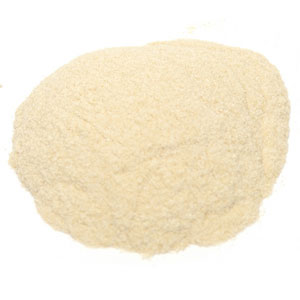
Pectin is a heteropolysaccharide, a structural polymer contained in the primary lamella, in the middle lamella, and in the cell walls of terrestrial plants. The principal chemical component of pectin is galacturonic acid which was isolated and described by Henri Braconnot in 1825. Commercially produced pectin is a white-to-light-brown powder, produced from citrus fruits for use as an edible gelling agent, especially in jams and jellies, dessert fillings, medications, and sweets; as a food stabiliser in fruit juices and milk drinks, and as a source of dietary fiber.

Marmalade Boy is a Japanese manga series written and illustrated by Wataru Yoshizumi. It was published in Shueisha's shōjo manga magazine Ribon from May 1992 to October 1995 and collected in eight tankōbon volumes. The series was adapted by Toei Animation as a 76-episode anime television series which aired on TV Asahi in 1994 to 1995. This was followed by a prequel theatrical anime movie in 1995. The series was also adapted as a 30-episode live-action television series that was broadcast in Taiwan in 2002. A live-action film adaptation was released in Japan by Warner Bros. Pictures on April 27, 2018.

A chutney is a spread typically associated with cuisines of the Indian subcontinent. Chutneys are made in a wide variety of forms, such as a tomato relish, a ground peanut garnish, yogurt, or curd, cucumber, spicy coconut, spicy onion, or mint dipping sauce.

"Lady Marmalade" is a song written by Bob Crewe and Kenny Nolan that is famous for the French refrain of "Voulez-vous coucher avec moi, ce soir?", which is a sexual proposition that translates into English as: "Do you want to sleep with me, tonight?" The song first became a popular hit when it was recorded in 1974 by the American funk rock group Labelle and held the number-one spot on the Billboard Hot 100 chart for one week, and also topped the Canadian RPM national singles chart. In 2021, the Library of Congress selected Labelle's version for preservation in the National Recording Registry for being "culturally, historically, or aesthetically significant".

Krofne are airy filled doughnuts. They are round and usually filled with jelly, marmalade, jam or chocolate as well as butter, Nutella and cinnamon. They can also be filled with custard, or cream, but that is usually less common. The name comes from German Krapfen, and it is a variation of the Central European pastry known as the Berliner. They are also similar to beignets.
Robertson's is a British brand of marmalades and fruit preserves that was founded by James Robertson in 1864. The firm was run as a partnership until 1903, when it was incorporated as a limited company: James Robertson & Sons, Preserve Manufacturers, Limited. It produces the "Golden Shred" marmalade, a recipe created in 1874 and registered as a trademark in 1886, among other products including "Silver Shred" a lemon marmalade launched in 1909; "Mincemeat", a traditional Scottish style mincemeat made from raisins, peel, sugar and beef suet; and "Bramble Jelly", a traditional Scottish style jam, strained of its seeds. Robertson's received their first Royal Warrant from King George V in 1933.

Cinnamon sugar is a mixture of ground cinnamon and granulated sugar used as a spice to flavor foods such as Belgian waffles, Snickerdoodle cookies, tortillas, coffee cake, French toast, and churros. It is also used to flavor apples, cereals, and other fruits. As McCormick describes cinnamon sugar, "it’s the comforting scent of Sunday morning cinnamon toast and mid-summer’s peach cobbler...the aroma of the holidays, with cinnamon cookies and spice cake."
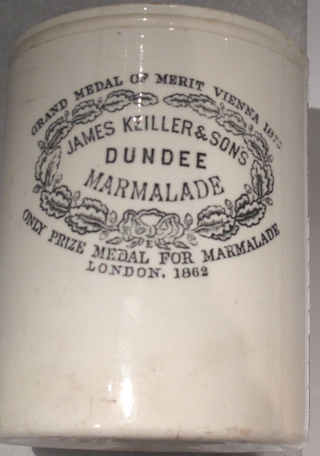
Keiller's marmalade is a Scottish marmalade, believed to have been the first commercial brand made in Great Britain. It was first manufactured by James Keiller in Dundee, Scotland, later creating James Keiller & Son, a brand name which became iconic in the 18th and 19th centuries, and has been sold several times.
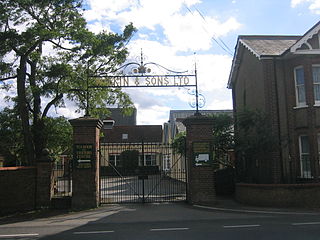
Wilkin & Sons Limited is a manufacturer of preserves, marmalades and associated products established in Tiptree, Essex, England in 1885, and known for its "Tiptree" brand of fruit preserves.

Fruit preserves are preparations of fruits whose main preserving agent is sugar and sometimes acid, often stored in glass jars and used as a condiment or spread.

Hartley's is a British brand of marmalades, jams and jellies. Founded by Sir William Hartley in 1871, Hartley's products are manufactured at Histon, Cambridgeshire, England. The brand was formerly owned by Premier Foods, until it was sold along with the factory in Histon to Hain Celestial for £200 million in October 2012. Hartley's operates as a brand of Hain Celestial's subsidiary of the United Kingdom, Hain Daniels.
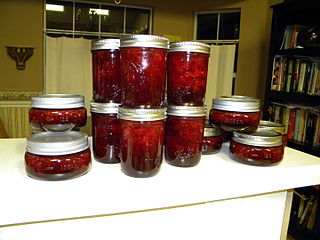
Gelling sugar or (British) Jam sugar or (US) Jelly sugar or sugar with pectin is a kind of sugar that is used to produce preserves, and which contains pectin as a gelling agent. It also usually contains citric acid as a preservative, sometimes along with other substances, such as sorbic acid or sodium benzoate
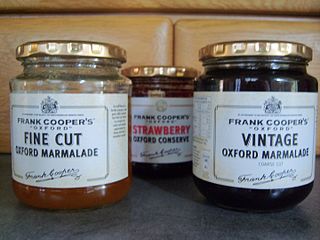
Frank Cooper's is a UK brand of marmalades and jams owned by Hain Daniels. Frank Cooper's is known primarily for its "Oxford" Marmalade and holds a Royal Warrant. The brand was created by Sarah Cooper in 1874 and as of 2012 is a brand of Hain Celestial Group.

Quince cheese is a sweet and tart, thick jelly made of the pulp of the quince fruit. It is a common confection in several countries.

Cornulețe are Romanian and Moldovan pastries aromatised with vanilla or rum extract/essence, as well as lemon rind, and stuffed with Turkish delight, jam, chocolate, cinnamon sugar, walnuts, and/or raisins, with the shape representing a crescent. They are traditionally eaten during Romanian holidays, especially during Christmas time, or other special occasions.

Cheong is a name for various sweetened foods in the form of syrups, marmalades, and fruit preserves. In Korean cuisine, cheong is used as a tea base, as a honey-or-sugar-substitute in cooking, as a condiment, and also as an alternative medicine to treat the common cold and other minor illnesses.

The Jam Museum is a gastronomic museum opened in 2004 in Torrent, in the Baix Empordà region of Spain. Its creator is Georgina Regàs, also author of the book 70 confitures.
References
- ↑ "Preserving Sugar". www.silverspoon.co.uk. Archived from the original on 2021-12-08. Retrieved 2021-12-08.
- ↑ "Preserving Sugar". Archived from the original on 2016-11-04. Retrieved 2016-11-04.
- ↑ "Marmalade - Perserving vs Jam Sugar". www.nigella.com. Retrieved 2024-03-09.